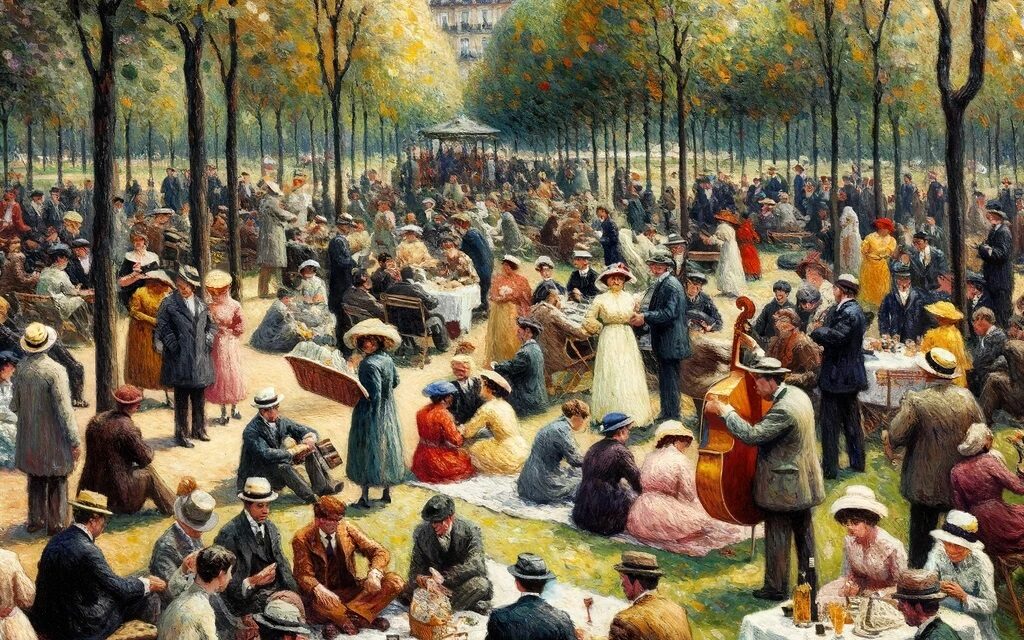Listen to this blog
Welcome to our blog post, where we embark on a fascinating journey through the world of art, specifically the captivating realm of Post-Impressionism. Delve into the evolution of this influential art movement, as we unravel its wonders and explore the profound impact it has had on the art world. Post-Impressionism emerged as a response to the limitations of Impressionism, pushing boundaries and challenging traditional artistic techniques. Led by visionary artists such as Vincent van Gogh, Paul Cézanne, and Georges Seurat, this movement revolutionized the way we perceive art by daring to experiment with colour, form, and composition. Join us as we unveil the extraordinary beauty and complexity of Post-Impressionist masterpieces, and discover why this artistic revolution continues to inspire and captivate audiences around the globe.
Post-Impressionism: A Brief Overview
Post-Impressionism, an influential artistic movement, emerged in the late 19th century as a powerful response to the revolutionary style of Impressionism. Originating from the vibrant city of Paris, this movement introduced a plethora of groundbreaking techniques and approaches to art-making, forever altering the course of artistic expression. Post-Impressionists challenged the status quo by boldly experimenting with various elements, such as the innovative use of vivid and contrasting colours, the exploration of abstract forms, and a heightened emphasis on line and form. This deliberate departure from traditional artistic norms allowed Post-Impressionists to explore new avenues of creativity and to convey emotions and ideas in an unprecedented manner. Through their unwavering commitment to pushing artistic boundaries, these pioneers paved the way for future generations of artists, leaving an indelible mark on the history of art.
Post-Impressionism, a French art movement that developed roughly between 1886 and 1905, witnessed the emergence of some of the most renowned post-impressionist painters in art history. Among these luminaries were Paul Cézanne, Vincent van Gogh, Georges Seurat, Paul Signac, Henri de Toulouse-Lautrec, Odilon Redon, and Pierre Bonnard. Each artist, in their own right, contributed significantly to the evolution of this movement, forging a distinct style that revolutionized the world of painting. Through tireless experimentation with elements such as light, space, composition, and colour theory, these visionaries pushed the boundaries of artistic expression and left an indelible mark on the art scene.
Thus, the legacy of post-impressionism continues to resonate in the art world today. The transformative impact of this movement cannot be overstated, as modern movements such as Cubism and Expressionism owe a debt of gratitude to the innovative and groundbreaking techniques pioneered by the post-impressionists. Their emphasis on individual artistic vision, bold use of colour, and departure from naturalistic representation paved the way for contemporary painters who are inspired by their enduring legacy. Even in the ever-evolving landscape of art, the influence of post-impressionism remains a powerful force that continues to shape and inspire new generations of artists.
Origins of the Post-Impressionist Movement
Post-Impressionism, an influential art movement that emerged during the late 19th century, was a direct response to the preceding Impressionist movement. This artistic transition was marked by a deliberate rejection of naturalistic representation, as Post-Impressionist artists sought to explore new avenues of expression through their work. Central to this movement was a strong emphasis on evoking profound emotions, utilizing symbolism, and embracing the subjective interpretation of the artist. Departing from the Impressionist focus on capturing fleeting moments in time and light, Post-Impressionism sought to convey deeper messages and meanings through art. By employing bold brushwork, vibrant colours, and unconventional compositions, Post-Impressionist artists aimed to elicit visceral reactions from viewers and challenge traditional artistic conventions. Notable figures such as Vincent van Gogh, Paul Cézanne, and Georges Seurat spearheaded this movement, leaving an indelible mark on the development of modern art. Through their fearless experimentation and innovative techniques, Post-Impressionist artists paved the way for future generations of artists to explore their own unique visions, forever reshaping the trajectory of artistic expression.
Post-Impressionism, a pivotal movement in the history of art, originated in France as a direct response to the Impressionist movement that had come to prominence in the preceding decades. Seeking to liberate themselves from the confinement of traditional and realistic painting styles, the artists associated with Post-Impressionism embarked on a revolutionary journey. Their aim was not merely to capture the visual reality as Impressionists had done, but rather to delve deep into their own inner worlds and express their emotions and experiences through more symbolic representations. In this profound exploration of self, they challenged viewers to engage with art on a higher level, transcending the surface-level impressions and delving into the intricate tapestry of human existence. Through their masterful brushstrokes and innovative techniques, Post-Impressionists forever altered the course of artistic expression, leaving an indelible mark on the history of art.
Finally, Post-Impressionism emerged as a transformative movement in the late 19th century, challenging traditional artistic conventions and paving the way for 20th-century abstract art. Led by renowned artists such as Paul Cézanne, Georges Seurat, Vincent van Gogh, Paul Gauguin, and Henri de Toulouse-Lautrec, this new expressionist style of painting boldly rejected realism and, instead, embraced a heightened focus on colour theory and evocative compositions. Through their experimentation with brushwork, colour juxtapositions, and subjective interpretations of the world around them, these avant-garde painters laid the foundation for an artistic revolution that would shatter the boundaries of representation and allow for unparalleled creative freedom. Their influential contributions to Post-Impressionism not only shaped the course of modern art but also challenged viewers to delve beyond mere visual perception and explore the depths of emotion and personal expression within art.
Notable Post-Impressionist Artists and their Contributions
Post-Impressionism, a French art movement that developed roughly between 1886 and 1905, emerged as a significant reaction to Impressionism. During the late 19th and early 20th centuries, this revolutionary style gained popularity in France, challenging the notion of reality and physical accuracy by delving into the depth of the artist’s emotions, personal meanings, and symbolic representations. Post-Impressionist artists sought to break free from the constraints imposed by Impressionism, establishing a new form of artistic expression that transcended mere visual representation. Symbolic of their authority and expertise, these artists aimed to create works that went beyond the surface level and captured the essence of their own experiences and perceptions. By emphasizing the individual artist’s perspective, Post-Impressionism not only transformed the art scene but also ignited a profound impact on subsequent artistic movements.
However, the impact of Post-Impressionism extended far beyond the individual contributions of its notable artists. This revolutionary movement, which emerged in the late 19th century, challenged the limitations of Impressionism and set the stage for the development of modern art in the 20th century. The artists mentioned above, such as Paul Cézanne, Vincent van Gogh, Paul Gauguin, and Henri Rousseau, each brought their own distinctive style and artistic vision to the Post-Impressionist movement. Their exploration of structure, simplification, vibrant colours, and bold brushstrokes defied the traditional norms of painting and opened the door for a new era of artistic expression. Post-Impressionism paved the way for artists to break free from the constraints of naturalism and embrace subjective interpretations of reality, leading to the emergence of various other influential art movements in the years to come. As a result, Post-Impressionism holds a significant place in art history as a turning point that revolutionized the way art was perceived and created.
Techniques and Elements Used in Post-Impressionism
Post-Impressionism, a significant art movement that unfolded in France during the 1880s, represents a bold departure from the conventional techniques and elements employed in Impressionism. This artistic revolution was characterized by a deliberate rejection of the limitations imposed by Impressionism, marking a pivotal moment in the evolution of modern art. Artists associated with Post-Impressionism sought to expand and transform the foundations laid by their predecessors, exploring new possibilities of expression and pushing the boundaries of artistic representation. With its emphasis on subjective interpretation and a departure from naturalistic depictions, Post-Impressionism challenged the prevailing norms and paved the way for further artistic experimentation. By exploring themes such as colour theory, abstract forms, and symbolic representations, Post-Impressionist painters like Vincent van Gogh, Paul Cézanne, and Paul Gauguin significantly contributed to the development of 20th-century art movements. Through its rejection of traditional Impressionist techniques, Post-Impressionism has left an indelible mark on the history of art, forever influencing subsequent artistic endeavors and cementing its place in the annals of artistic innovation.
Thereafter, Post-Impressionism emerged as a significant movement in the art world, departing from the limitations of Impressionism and pushing the boundaries of artistic expression. The Post-Impressionist artists rejected the notion of simply capturing the visual appearance of the subject matter, instead seeking to convey deeper emotions, personal experiences, and inner worlds through their works. By employing simplified forms and vibrant colours, they aimed to evoke intense feelings and create powerful connections with the viewer. Through the use of curved lines, thick brushstrokes, and bold colours to represent light, shadow, and depth, these artists defied conventional techniques and embarked on a revolutionary journey of self-expression. Post-Impressionism became a revolution in art, paving the way for further exploration of the human experience and inspiring generations of artists to come.
Impact of Post-Impressionism on Modern Art
Post-Impressionism, a French art movement that developed roughly between 1886 and 1905, emerged as a powerful response to the preceding Impressionist style of painting. This revolutionary movement aimed to push the boundaries of artistic representation, particularly in terms of light and colour on canvas. Post-Impressionist artists sought to break away from the limitations of Impressionism by employing vivid colours and defined lines to create highly expressive works of art. Their approach revealed a deep exploration of emotions and subjective experiences, marking a significant departure from the objective observations of the Impressionists. With an authoritative tone, we can assert that Post-Impressionism marked a pivotal moment in the history of art, as these artists redefined traditional notions of beauty and challenged the very foundations of artistic expression.
Additionally, the enduring influence of Post-Impressionism on contemporary art cannot be overstated. Its defining elements, such as bold colour usage, intense symbolism, and an emphasis on emotional impact over visual accuracy, have become integral components of modern artistic expression. By incorporating these principles into their work, contemporary artists pay homage to the innovative spirit of the Post-Impressionist movement while also shaping our perception and appreciation of the world today. The lasting impact of Post-Impressionism serves as a testament to the power of art to transcend time and inspire new generations of artists to push boundaries and challenge conventional norms. As we continue to observe the profound influence of Post-Impressionism on modern art, we are reminded of its vital role in shaping our understanding of beauty, emotion, and the human experience.
Exploring the Wonders of Post-Impressionism
Post-Impressionism, a prestigious and influential French art movement that developed roughly between 1886 and 1905, emerged as a natural progression from Impressionism. Building upon the foundations laid by their Impressionist predecessors, the Post-Impressionists sought to explore the expressive use of colour, texture, line, and form to convey their artistic vision. This movement brought forth a new wave of artists who defied traditional artistic boundaries and pushed the boundaries of creativity. Through their innovative techniques and revolutionary approaches, Post-Impressionist artists made significant contributions to the world of art, leaving an indelible mark upon the history of artistic expression.
Also, Post-Impressionism, a French art movement that developed roughly between 1886 and 1905, revolutionized the artistic world by moving beyond the limitations of Impressionism. Through their expressive use of bold colours, simplified forms, and outlined shapes, Post-Impressionist artists sought to convey their own emotions and ideas, rather than merely recreate the physical world around them. This departure from the objective reality of Impressionism allowed for deeper introspection and a more subjective interpretation of the artist’s vision. The resulting works possessed a distinctly graphic quality that set them apart from their Impressionist predecessors. By pushing the boundaries of traditional artistic techniques and exploring new modes of expression, Post-Impressionism not only left an indelible mark on the art world, but also paved the way for subsequent artistic movements in the years to come.
Final Say
In conclusion, the wonders of Post-Impressionism cannot be overstated. This revolutionary movement not only pushed the boundaries of traditional artistic techniques but also challenged the way we perceive art itself. Led by visionary artists like Vincent van Gogh, Paul Cézanne, and Georges Seurat, Post-Impressionism continues to captivate and inspire audiences worldwide. By daring to experiment with colour, form, and composition, these artists have left an indelible mark on the art world. So join us on this journey of exploration, as we unveil the extraordinary beauty and complexity of Post-Impressionist masterpieces, and witness firsthand the profound impact it has had on the evolution of art.




